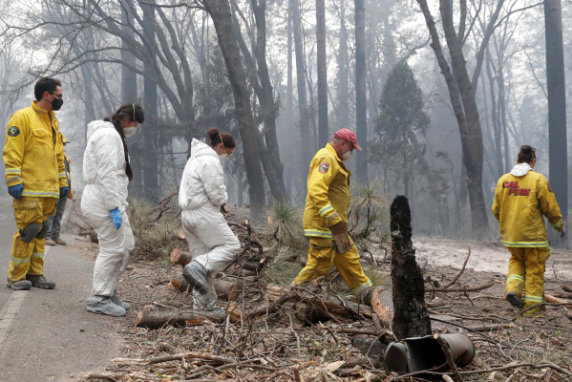At least 56 killed, 130 missing in California's deadliest wildfire
National Guard troops joined the grim search on Wednesday for more victims in the ruins of an incinerated northern California town while the death toll climbed to 56 in the most deadly and destructive wildfire in the state's history.
The latest fatality count was announced as authorities released a revised list of 130 people reported missing by loved ones after flames largely obliterated the Sierra foothills town of Paradise, about 175 miles (280 km) north of San Francisco, last Thursday.

The majority on the list were over the age of 65. Nearly 230 people were initially reported as missing in the killer blaze, dubbed the Camp Fire. Most of those who remain unaccounted for are from Paradise, once home to 27,000 people.
More than 8,900 homes and other buildings burned to the ground in and around Paradise, and an estimated 50,000 people remained under evacuation orders in the area.
Adding to the misery of some survivors was an outbreak of norovirus, a highly contagious gastrointestinal illness, at a shelter housing about 200 evacuees in the nearby city of Chico.
Public health agency spokeswoman Lisa Almaguer said at least 20 people may have caught the virus.
The footprint of the six-day-old fire grew to 135,000 acres (55,000 hectares) as of Wednesday, even as diminished winds and rising humidity helped firefighters shore up containment lines around more than a third of the perimeter.
Still, the ghostly expanse of empty lots covered in ash and strewn with twisted wreckage and debris made a strong impression on Governor Jerry Brown, US Interior Secretary Ryan Zinke and other officials who toured the devastation on Wednesday.
'This is one of the worst disasters I've seen in my career, hands down," Brock Long, head of the Federal Emergency Management Agency, told reporters in Chico.
'It looks like a war zone. It is a war zone,' Brown said.
No finger pointing
After visiting some of California's earlier wildfire zones in August, Zinke blamed 'gross mismanagement of forests' because of timber harvest restrictions that he said were supported by 'environmental terrorist groups'.
But pressed by reporters on Wednesday, Zinke demurred. 'Now is really not the time to point fingers,' he said. "It is a time for America to stand together.'
The blaze, fueled by thick, drought-desiccated scrub, has capped two back-to-back catastrophic wildfire seasons in California that scientists largely attribute to prolonged drought they say is symptomatic of climate change.
Lawyers for some of the victims claimed in a lawsuit filed on Wednesday that lax equipment maintenance by an electric utility was the proximate cause of the fire, which officially remains under investigation.
The Butte County disaster coincided with a flurry of blazes in Southern California, most notably the Woolsey Fire, which has killed at least two people, destroyed more than 500 structures and displaced about 200,000 people in the mountains and foothills near the Malibu coast west of Los Angeles.
On Wednesday, the Los Angeles County Sheriff's Department said the body of a possible third victim was found there in a burned-out dwelling. Cal Fire officials said that blaze was 52 per cent contained as of Wednesday night.
In Butte County, the search for more human remains kicked into high gear as a National Guard contingent of 50 military police officers joined dozens of search-and-recovery workers and at least 22 cadaver dogs, Sheriff Kory Honea said.
The remains of eight more fire victims were found on Wednesday, raising the official number of fatalities to 56 – far exceeding the previous record from a single wildfire in California history, 29 people killed by the Griffith Park fire in Los Angeles in 1933.
The Camp Fire also stands as one of the deadliest US wildfires since the turn of the last century. More than 80 people perished in the Big Burn firestorm that swept the Northern Rockies in August of 1910.
Tracking the missing
Butte County Sheriff's spokeswoman Megan McMann said the list of 130 missing would fluctuate from day to day as more names are added and others are removed, either because they turn up safe or end up identified among the dead.
Sheriff Honea invited relatives of the missing to provide DNA samples to compare against samples taken from newly recovered remains in hopes of speeding up identification of the dead. But he acknowledged it was possible some of the missing might never be found.
Authorities attributed the magnitude of casualties to the staggering speed with which the fire struck Paradise. Wind-driven flames roared through town so swiftly that residents were forced to flee for their lives. Some victims were found in or around the burned-out wreckage of their vehicles.
Anna Dise, a resident of Butte Creek Canyon west of Paradise, told KRCR TV her father, Gordon Dise, 66, died when he ran back inside to gather belongings and their house collapsed on him.
Dise said she could not flee in her car because the tires had melted. To survive, she hid overnight in a neighbor's pond with her dogs.
'It was so fast,' Dise recounted of the fire. 'I didn't expect it to move so fast.'











